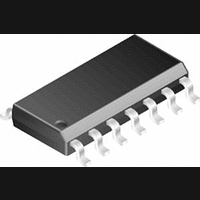LMC6034IM National Semiconductor, LMC6034IM Datasheet - Page 6

LMC6034IM
Manufacturer Part Number
LMC6034IM
Description
Operational Amplifier (Op-Amp) IC
Manufacturer
National Semiconductor
Specifications of LMC6034IM
No. Of Amplifiers
4
Slew Rate
1.1V/µs
No. Of Pins
14
Peak Reflow Compatible (260 C)
No
Leaded Process Compatible
No
Mounting Type
Surface Mount
Package / Case
14-NSOIC
Lead Free Status / RoHS Status
Contains lead / RoHS non-compliant
Available stocks
Company
Part Number
Manufacturer
Quantity
Price
Company:
Part Number:
LMC6034IM
Manufacturer:
NS
Quantity:
10 990
Part Number:
LMC6034IM
Manufacturer:
NS/国半
Quantity:
20 000
Part Number:
LMC6034IM-TEL
Manufacturer:
NS/国半
Quantity:
20 000
Part Number:
LMC6034IMX
Manufacturer:
NS/国半
Quantity:
20 000
Company:
Part Number:
LMC6034IMX/NOPB
Manufacturer:
ST
Quantity:
7 733
Part Number:
LMC6034IMX/NOPB
Manufacturer:
TI/德州仪器
Quantity:
20 000
www.national.com
Applications Hint
The large signal voltage gain while sourcing is comparable
to traditional bipolar op amps, even with a 600
gain while sinking is higher than most CMOS op amps, due
to the additional gain stage; however, under heavy load
(600 ) the gain will be reduced as indicated in the Electrical
Characteristics.
Compensating Input Capacitance
The high input resistance of the LMC6034 op amps allows
the use of large feedback and source resistor values without
losing gain accuracy due to loading. However, the circuit will
be especially sensitive to its layout when these large-value
resistors are used.
Every amplifier has some capacitance between each input
and AC ground, and also some differential capacitance be-
tween the inputs. When the feedback network around an
amplifier is resistive, this input capacitance (along with any
additional capacitance due to circuit board traces, the
socket, etc.) and the feedback resistors create a pole in the
feedback path. In the following General Operational Amplifier
circuit, Figure 2 the frequency of this pole is
where C
cluding amplifier input capcitance and any stray capacitance
from the IC socket (if one is used), circuit board traces, etc.,
and R
mula, as well as all formulae derived below, apply to invert-
ing and non-inverting op-amp configurations.
When the feedback resistors are smaller than a few k , the
frequency of the feedback pole will be quite high, since C
generally less than 10 pF. If the frequency of the feedback
pole is much higher than the “ideal” closed-loop bandwidth
(the nominal closed-loop bandwidth in the absence of C
the pole will have a negligible effect on stability, as it will add
only a small amount of phase shift.
However, if the feedback pole is less than approximately 6 to
10 times the “ideal” −3 dB frequency, a feedback capacitor,
C
ing input of the op amp. This condition can also be stated in
terms of the amplifier’s low-frequency noise gain: To main-
tain stability a feedback capacitor will probably be needed if
where
FIGURE 1. LMC6034 Circuit Topology (Each Amplifier)
F
, should be connected between the output and the invert-
P
is the parallel combination of R
S
is the total capacitance at the inverting input, in-
(Continued)
F
and R
IN
. This for-
load. The
DS011134-3
S
S
is
),
6
is the amplifier’s low-frequency noise gain and GBW is the
amplifier’s
low-frequency noise gain is represented by the formula
regardless of whether the amplifier is being used in inverting
or non-inverting mode. Note that a feedback capacitor is
more likely to be needed when the noise gain is low and/or
the feedback resistor is large.
If the above condition is met (indicating a feedback capacitor
will probably be needed), and the noise gain is large enough
that:
the following value of feedback capacitor is recommended:
If
the feedback capacitor should be:
Note that these capacitor values are usually significantly
smaller than those given by the older, more conservative for-
mula:
C
from the circuit board and socket. C
C
Using the smaller capacitors will give much higher band-
width with little degradation of transient response. It may be
necessary in any of the above cases to use a somewhat
larger feedback capacitor to allow for unexpected stray ca-
S
S
consists of the amplifier’s input capacitance plus any stray capacitance
and the feedback resistors.
FIGURE 2. General Operational Amplifier Circuit
gain
bandwidth
F
compensates for the pole caused by
product.
DS011134-4
An
amplifier’s











